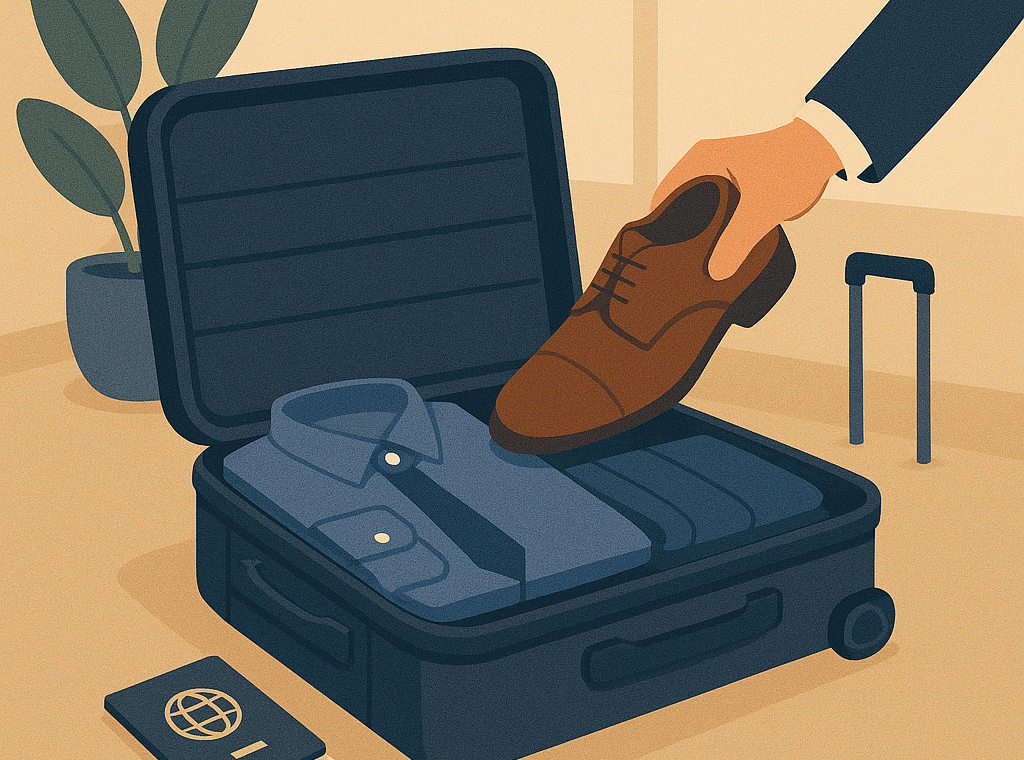How to Pack for Business Travel in a Carry-On: Tips and Tricks
Tired of stressful business trips? Learn to pack like a pro! Discover how versatile wardrobes, carry-on essentials, and smart packing cubes can maximize your productivity and minimize travel hassles. Explore expert tips on choosing the right luggage, avoiding baggage fees, and staying organized on the go. Streamline your next business trip – read more now!
Important information
- Pack versatile clothing suitable for both business and social events to minimize luggage.
- Keep essential documents, electronics, and chargers in your carry-on for easy access.
- Use packing cubes to organize belongings and maximize space. Travel-sized toiletries also help save space.
- Choose durable, lightweight luggage appropriate for your trip’s length. Check airline baggage restrictions to avoid fees.
- Rolling clothes (especially casual wear) can minimize wrinkles and save space. Folding is better for formal attire.
Understanding the Basics of Packing for Business Travel
Plan a versatile wardrobe. Pack clothing suitable for both business meetings and social events to minimize the amount of luggage.
Prioritize carry-on essentials. Keep crucial documents, electronics, and chargers in your carry-on for easy access during the trip.
Maximize space with travel-sized toiletries. These compact items free up valuable space in your luggage.
Maintain order with packing cubes. These organizers help keep your belongings neat and compartmentalized throughout your trip.
Choose appropriate luggage. Select sturdy yet lightweight luggage that suits your trip’s length and planned activities.
Never forget a portable charger. A portable charger is essential for keeping your devices powered up while on the go.
Smart packing is crucial for a productive business trip. Efficient packing not only saves time but also minimizes stress, allowing you to focus on your work.
- Reduces stress,
- saves valuable time,
- and increases overall productivity.
Versatile clothing suitable for both meetings and social events minimizes the need for excess baggage, making travel more convenient.
- Minimizes baggage,
- increases convenience,
- and provides flexibility for various occasions.
Importance of Planning Ahead for a Smooth Trip
Planning ahead streamlines business travel. Packing essentials in your carry-on minimizes potential disruptions and allows you to adapt to unforeseen issues. For instance, efficient packing, such as rolling your clothes, saves space and prevents wrinkles. Durable luggage is also a smart investment, improving both security and organization. Here’s a breakdown of how to prepare:
Choose the right luggage. Invest in durable, lightweight luggage with good organization features.
Make a packing list. Consider the length of your trip and any specific business needs.
Pack smart. Roll your clothes to save space and minimize wrinkles. Use packing cubes to keep items organized.
Essentials in your carry-on. Keep essential items, such as medications, electronics, and important documents, in your carry-on bag.
Choosing the Right Luggage for Business Travel
Packing efficiently for a business trip depends on the length and schedule of your trip. For short trips, a carry-on suitcase with a briefcase or backpack is usually enough. Longer trips may require a larger checked bag. Always check your airline’s carry-on size and weight limits. Choose luggage that is both strong and light. Smart organization is essential. Bags like the Tri-Star, Pilot, and Western Flyer are great choices for business travel, as they offer durable construction and smart compartments. Consider your own needs, too. Besides size, think about features like wheels and comfortable handles for easier carrying. The right bag can make business travel much simpler.
For short business trips
A carry-on suitcase and a briefcase or backpack are usually sufficient for short business trips.
For longer business trips
You might need a larger checked bag for longer business trips. Always confirm your airlines carry-on size and weight restrictions.
Choose durable and lightweight luggage.
Organize your belongings smartly.
Consider bags like the Tri-Star, Pilot, and Western Flyer for their robust construction and intelligent compartments.
Evaluate features such as wheels and comfortable handles for easy transport.
How to Choose the Right Carry-On Bag
Standard domestic carry-on size limits are approximately 22 x 14 x 9 inches.
Choose a durable, lightweight bag such as a suitcase, duffel bag, or backpack.
Bags with multiple compartments can help with organization.
Always confirm your specific airline’s carry-on rules and regulations to avoid any issues at the airport.
Benefits of Traveling with a Single Piece of Luggage
Traveling light offers numerous advantages. Navigating airports becomes effortless, and you can bypass baggage fees, skipping the wait at baggage claim entirely. This not only saves time but also reduces travel stress considerably. With all your possessions readily at hand, you’ll have greater control, minimizing the risk of loss or damage. Furthermore, managing a single bag is far simpler, especially on public transport and when hopping between destinations. Here’s a summary of the benefits:
- Effortless airport navigation.
- No baggage fees.
- Skip baggage claim wait times.
- Reduced travel stress.
- Greater control over possessions.
- Minimized risk of loss or damage.
- Easier management, especially on public transport.
Creating an Effective Business Trip Packing List
Smart packing is essential for a smooth business trip. Before you begin, create a comprehensive packing list and then refine it to include only essential items. Select versatile clothing options such as suits, slacks, and dress shirts that can be mixed and matched. Also, pack casual, wrinkle-resistant garments for relaxing during your downtime. Be sure to consider the destination’s climate and dress code when making your selections.
Luggage Choice
For short business trips, a carry-on suitcase with packing cubes is ideal. This allows you to avoid checked baggage fees and streamline your travel experience. Packing cubes help organize your belongings and maximize space within your carry-on.
Longer Trips
If you are embarking on a longer business trip, a larger suitcase is necessary to accommodate more clothing and other essentials. Ensure it has durable wheels and a comfortable handle for easy maneuverability.
Organize Your Belongings
Categorize your items into groups such as clothing, electronics, and toiletries. This systematic approach allows for quick and easy access to your belongings throughout your trip.
Weight Distribution
Place heavier items at the bottom of your suitcase to ensure even weight distribution. This prevents your luggage from becoming top-heavy and tipping over. It also helps maintain the shape and integrity of your suitcase.
Essential Documents
Remember to pack all crucial documents, including your passport, itinerary, boarding pass, and hotel information. Keep these documents organized and easily accessible in a designated travel wallet or pouch.
Electronics
Don’t forget essential electronics such as your phone, laptop, chargers, and any necessary adapters. Consider a portable power bank to keep your devices charged on the go.
Comfort Items
Enhance your travel experience by packing a reusable water bottle and personal comfort items such as a travel pillow, eye mask, and earplugs. These items can help you stay hydrated, comfortable, and well-rested during your journey.
Essentials for Your Packing List
Pack smart for a smooth trip. Here’s a checklist:
- Travel Documents: passport, itinerary, and boarding pass.
- Electronics: laptop, phone, and chargers.
- Clothing: professional attire (suit, dress shirt, and appropriate shoes) and casual wear (t-shirts and jeans).
- Toiletries: essentials for freshening up.
- Reusable Water Bottle: stay hydrated on the go.
- Entertainment: a book or other preferred item.
- First-Aid Kit: pain relievers, personal medications, and other essentials.
- Packing Cubes: organize your belongings efficiently.
Including Versatile Clothing Items
Pack versatile clothing items that can be mixed and matched to create a variety of outfits. This strategy allows for greater flexibility and lighter packing.
- A dark blazer is an excellent choice, paired with neutral pants or a skirt.
- Several blouses or shirts offer numerous combinations.
- A simple dress can easily be dressed up or down.
Opt for wrinkle-resistant fabrics to minimize ironing. Comfortable yet professional shoes are essential, but don’t forget a casual pair for downtime.
- Remember the basics: undergarments and sleepwear.
Organizational Tools: Packing Cubes and More
Packing cubes are a traveler’s best friend for organizing carry-on bags. They neatly separate clothing categories like shirts, pants, and underwear, making it easy to find what you need without unpacking everything. Compression bags are another useful tool, minimizing wrinkles and maximizing space. For toiletries and electronics, pouches are ideal. Travel-sized toiletries not only comply with airline regulations, but also save valuable space.
Smart Clothing Strategies for Business Travel
Pack your clothes smartly to minimize wrinkles. Neatly folding them along the seams and then tightly rolling each item saves space and prevents creases. Packing cubes can also help organize clothes by type. Upon arrival, hang everything to release any remaining wrinkles. For truly wrinkle-free travel, consider suits made from wrinkle-resistant synthetic fabrics.
For casual clothes like t-shirts and jeans, rolling is a great space-saving method that also minimizes wrinkles. However, folding is preferable for dress clothes, particularly suits, as it helps them maintain their shape. Delicate items benefit from the extra protection of garment bags, keeping them looking their best.
How to Pack Wrinkle-Resistant Clothing
Roll your clothes instead of folding them to save space and prevent wrinkles.
For smoother results, fold along the seams before rolling.
Use packing cubes to organize rolled items and maximize luggage space.
For business trips, consider wrinkle-resistant synthetic suits.
Hang your clothes upon arrival to help release any remaining creases.
Rolling vs. Folding: Best Practices
Rolling casual clothes, such as t-shirts, jeans, and knitwear, is great for saving space and minimizing wrinkles.
Dressier items like shirts, blazers, and formal wear, hold their shape better when folded.
For optimal packing, combine these methods: roll casual pieces and fold formal ones for efficient and light travel.
Packing Tips for Toiletries and Electronics
Pack smart for seamless business trips. Here’s how:
Toiletries
- Use travel-sized toiletries (3.4 ounces or less) in a clear, quart-sized bag.
- Consider reusable travel bottles for your favorite toiletries for an eco-friendly option.
- Alternatively, use solid toiletries, such as shampoo bars and solid deodorant, to save space and bypass liquid restrictions.
Electronics
- Keep electronics like laptops, phones, and chargers in your carry-on for easy access and security.
- Organize your carry-on electronics with compartments or pouches to prevent tangled cords and protect devices.
- Bring a portable charger for convenient on-the-go power.
Efficient Packing of Travel-Sized Toiletries
Traveling light? Pack travel-sized toiletries to save space and breeze through airport security. Remember, liquids, gels, and aerosols need to be in a quart-sized, clear, zip-top bag, with each container holding 3.4 ounces (100 milliliters) or less. Think shampoo, conditioner, and lotion. Alternatively, solid toiletries like bar soap and shampoo bars are a great option, bypassing these size restrictions. Reusable travel bottles are also perfect for your favorite liquid essentials.
Secure Storage of Electronics
Safeguard your electronics from bumps and scratches during travel by using a dedicated organizer or the padded compartments in your carry-on.
Keep your laptop, tablet, and camera in your carry-on for easy access and to minimize the risk of damage or loss.
Organize cords and chargers with pouches or cable ties to prevent tangling and ensure they are readily available.
For delicate electronics, consider using a hard-shell case for added protection.
Managing Travel Documents and Personal Items
Prepare for a smooth trip by ensuring you have these essential travel documents: your passport, necessary visas, itinerary, boarding pass, and hotel confirmations. Keep these documents secure and easily accessible in a travel wallet or folder. A digital backup on your phone or in the cloud is also recommended. Before packing, check your airline’s baggage size and weight restrictions to avoid extra fees. Using packing cubes and compression bags can help you optimize luggage space and minimize weight, allowing you to pack more efficiently.
Essential Travel Documents: Passport, Itinerary, Boarding Pass
- Your passport serves as your main identification document for international travel, essential for crossing borders.
- An itinerary outlines your travel schedule, encompassing flight details, hotel reservations, and planned activities.
- A boarding pass is your ticket to board the aircraft, specifying your seat assignment and flight information.
How to Avoid Airline Fees with Smart Packing
Save money by following your airline’s baggage rules. Most airlines allow a personal item, like a laptop bag, and a carry-on suitcase, but size and weight limits vary. Check these restrictions in advance to avoid extra fees.
Tips for Efficient Packing
- Roll your clothes instead of folding.
- Use packing cubes to maximize space.
- Wear your heavier items, such as your jacket and boots, on the plane to save luggage space and weight.
Checked Baggage
If you need to check a bag, be sure to review your airline’s specific size and weight limits, as well as any applicable fees. Checking baggage dimensions and weight in advance can help you avoid unexpected costs at the airport.



















